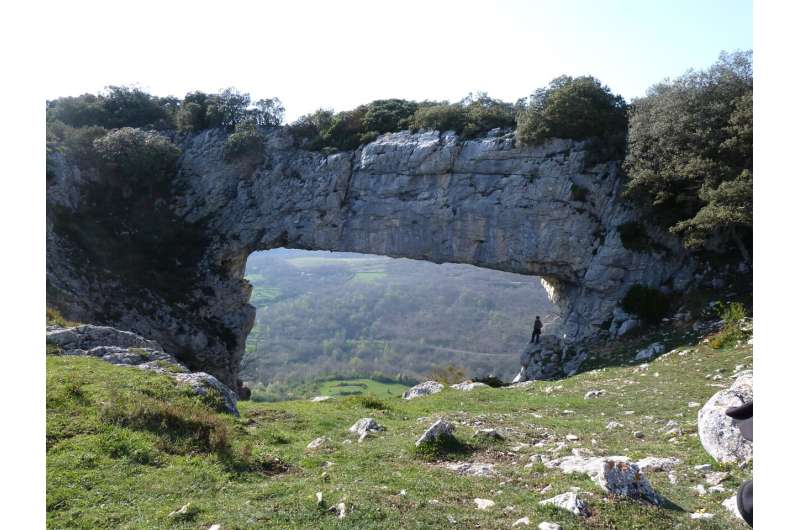Analyzing the landscape of the Ojo Guareña karst cave complex
Alfonso Benito Calvo, the scientific supervisor at the Digital Mapping and 3D Analysis Laboratory at the Centro Nacional de Investigación sobre la Evolución Humana (CENIEH), has participated in a paper published in the Journal of Maps on the evolution of the landscape in the Ojo Guareña Valley. The study has furnished the first results on the evolution of the landscape and the formation of this great karstic cave complex in the north of the province of Burgos (Spain), which is one of Europe’s largest.
In the study, which consisted of a geomorphological analysis of the territory and the compilation of a detailed mapping, the landscape units, or the landforms, were recognized by aligning this with the published speleological information about the karst complex. The geomorphological mapping made it possible to distinguish no fewer than 13 phases of erosion and lowering of the relief, occurring mainly during excavation of the valleys in the Quaternary. Eight of these phases have been correlated with the formation of the cave levels in the Ojo Guareña karst complex, that took place from over 1.2 million years ago to the present day.
“As erosion of the valleys that was lowering the relief progressed, the waters from the rivers infiltrated into the limestone rocks at ever deeper levels, forming the great network of cavities at Ojo Guareña,” says Benito Calvo, who directs the Geomorphology and Formation Processes line of research at the CENIEH.
Scientists investigate the origin of the Quaternary valleys in the Iberian peninsula
Theodoros Karampaglidis et al, Landscape evolution and the karst development in the Ojo Guareña multilevel cave system (Merindad de Sotoscueva, Burgos, Spain), Journal of Maps (2022). DOI: 10.1080/17445647.2022.2128907
Provided by
CENIEH
Citation:
Analyzing the landscape of the Ojo Guareña karst cave complex (2022, October 18)
retrieved 18 October 2022
from https://phys.org/news/2022-10-landscape-ojo-guarea-karst-cave.html
This document is subject to copyright. Apart from any fair dealing for the purpose of private study or research, no
part may be reproduced without the written permission. The content is provided for information purposes only.

Alfonso Benito Calvo, the scientific supervisor at the Digital Mapping and 3D Analysis Laboratory at the Centro Nacional de Investigación sobre la Evolución Humana (CENIEH), has participated in a paper published in the Journal of Maps on the evolution of the landscape in the Ojo Guareña Valley. The study has furnished the first results on the evolution of the landscape and the formation of this great karstic cave complex in the north of the province of Burgos (Spain), which is one of Europe’s largest.
In the study, which consisted of a geomorphological analysis of the territory and the compilation of a detailed mapping, the landscape units, or the landforms, were recognized by aligning this with the published speleological information about the karst complex. The geomorphological mapping made it possible to distinguish no fewer than 13 phases of erosion and lowering of the relief, occurring mainly during excavation of the valleys in the Quaternary. Eight of these phases have been correlated with the formation of the cave levels in the Ojo Guareña karst complex, that took place from over 1.2 million years ago to the present day.
“As erosion of the valleys that was lowering the relief progressed, the waters from the rivers infiltrated into the limestone rocks at ever deeper levels, forming the great network of cavities at Ojo Guareña,” says Benito Calvo, who directs the Geomorphology and Formation Processes line of research at the CENIEH.
Scientists investigate the origin of the Quaternary valleys in the Iberian peninsula
Theodoros Karampaglidis et al, Landscape evolution and the karst development in the Ojo Guareña multilevel cave system (Merindad de Sotoscueva, Burgos, Spain), Journal of Maps (2022). DOI: 10.1080/17445647.2022.2128907
Provided by
CENIEH
Citation:
Analyzing the landscape of the Ojo Guareña karst cave complex (2022, October 18)
retrieved 18 October 2022
from https://phys.org/news/2022-10-landscape-ojo-guarea-karst-cave.html
This document is subject to copyright. Apart from any fair dealing for the purpose of private study or research, no
part may be reproduced without the written permission. The content is provided for information purposes only.
